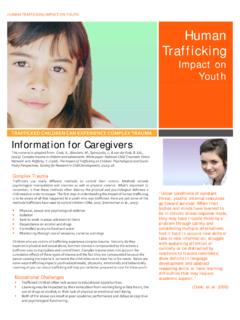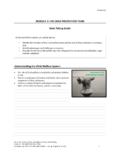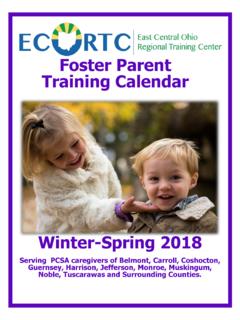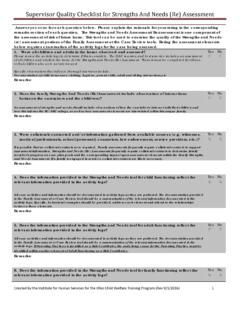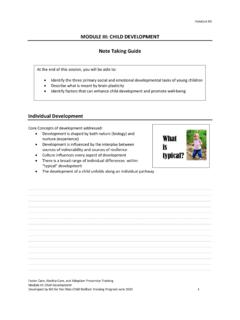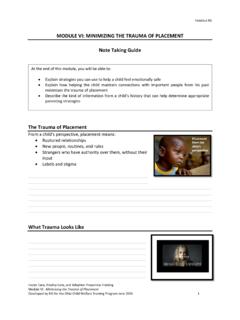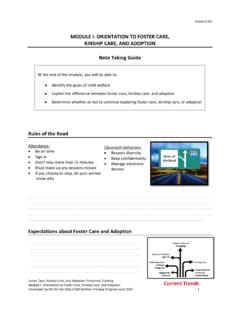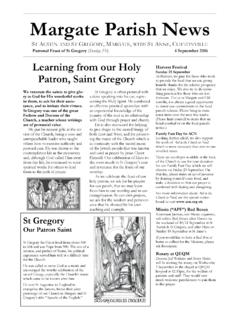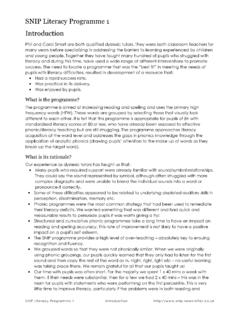Transcription of Normalcy and the Reasonable and Prudent Parent Standard
1 Normalcy and the Reasonable and Prudent Parent Standard By now, you have probably heard the term Normalcy used at your agency and workers may have mentioned the Reasonable and Prudent Parent Standard . This brief guide explains these concepts and provides a beginning understanding of what it means to you as a foster caregiver. Navigation: Hover over the question and left click to follow the link to the response. To return to the top of the page, hover over the green caret at the end of the response and left click. What is Normalcy ? Why is Normalcy important? What is the Reasonable and Prudent Parent Standard ? Why are we talking about this now? What does it mean to me as a foster caregiver? What factors do I need to consider when applying the Reasonable and Prudent Parent Standard ? How is Ohio working to normalize foster care?
2 How will my agency help me normalize the experience of the child in my home? Where can I get more information? What is Normalcy ? Normalcy can be defined as the ability to easily participate in age-appropriate social, scholastic, and enrichment activities.. The Juvenile Law Center (2015) writes that Normalcy is ensuring a child's range of experiences while in foster care is typical of the range of experiences of any child of the same age. They feel it is important for children to practice the skills they will need as an adult while they are still in a protected environment. These experiences help them build relationships, develop skills, and prepare for adulthood.. The Center for the Study of Social Policy's (2014) definition of Normalcy focuses on activities that promote well-being. ^. Why is Normalcy important?
3 When youth are not able to participate in activities that are needed for development, they are unprepared for life as an adult. Many youth who age out of foster care experience unemployment or inadequate income, homelessness, and incarceration. ( ). Normalcy and the RPPS Guide June 2015 1. Developed by the Institute for Human Services for the Ohio Child Welfare Training Program The development of the adolescent brain provides a window of opportunity. Just as relationships are the key to positive early childhood development, relationships continue to be necessary in adulthood. Foster caregivers need to help teens navigate through this transitional time by providing them normal experiences and helping them think through life decisions (Henderson, 2011;. Farruggia, 2006). Youth in care need Normalcy so that they can build their social capital.
4 Social capital is the value that is created by investing in relationships with others through processes of trust and reciprocity . (Juvenile Law Center, 2015). Most youth in care have experienced trauma so they need support in the emotional development and well-being, not just appropriate cultural and social activities (Center for the Study of Social Policy, 2014). Allowing youth to test boundaries while in care can help them learn about natural consequences and the importance of making positive choices (Texas Department of Family And Protective Services, 2013). ^. What is the Reasonable and Prudent Parent Standard ? The Standard characterized by careful and sensible parental decisions that maintain a child's health, safety, and best interests while at the same time encouraging the child's emotional and developmental growth, that a caregiver shall use when determining whether to allow a child in the care of the caregiver to participate in extracurricular, enrichment, and social activities (ACYF-CB-IM-14-03, 2014; ORC.)
5 , 2014). ^. Why are we talking about this now? Public Law 113-183, the Preventing Sex Trafficking and Strengthening Families Act, was passed in 2014. This law requires states to implement a Reasonable and Prudent Parent Standard to support Normalcy for children in care. To learn about other provisions in this law, see the resource Fact Sheet on HR4980. This law focuses on the child welfare goal of well-being, after years of restrictive policies that put safety over well-being (Juvenile Law Center, 2015). The provisions in this bill are effective one year after enactment (September 29, 2015). Ohio passed a similar law in 2014, Ohio House Bill 213. This law went into effect September, 2014. ^. What does it mean to me as a foster caregiver? As a foster caregiver, you will have the responsibility of making decisions related to normal activities.
6 To feel confident in taking on this responsibility: o Take advantage of training being offered. o Communicate with your licensing agency and the custodial agency and consider the policies and practice of both agencies when applying the Reasonable and Prudent Parent Standard Normalcy and the RPPS Guide June 2015 2. Developed by the Institute for Human Services for the Ohio Child Welfare Training Program o Respect your role as nurturer to the child and advocate for, and encourage participation in, normal activities o Hone your assessment skills, both the ability to assess the child's development and decision- making skills and the ability to assess the activity as age-appropriate, safe, and in compliance with laws and policies. ^. What factors do I need to consider when applying the Reasonable and Prudent Parent Standard ?
7 Both the Federal and State laws provide a specific list of factors to consider: o Child's age, maturity and developmental level Example: Even though the child is 14, will the PG-13 movie have content that the child isn't able to handle without behavioral issues or strong emotional responses? o Potential risk factors Example: What is the risk difference in allowing a child to ride with a friend to school vs. allowing him to ride with a friend to late night concert? o Best interest of the child Example: Was the sleep away camp selected because it fits the child's interest and is what she wants to do, or is it to give the caregivers a break ? o Emotional and developmental growth Example: Will being on the soccer team help build the child's self-esteem and develop the social skills she needs? o Family-like living experience Example: Is this something the caregiver would let her birth or adopted children do?
8 Is the only thing preventing the activity an agency policy? o Child's behavioral history Example: Given this child's history of underage drinking, is allowing him to stay out late with friends unsupervised a Prudent decision? ^. How is Ohio working to normalize foster care? Even though the Federal law does not mandate state legislation, Ohio is one of the leaders in implementing Normalcy and passed state legislation in September 2014 (Juvenile Law Center, 2015). There are two sections of the Oho Revised Code (ORC) that address Normalcy and the Reasonable and Prudent Parent Standard . ORC Participation in extracurricular enrichment, and social activities o Defines age-appropriate as activities that are generally accepted as suitable for children of the same chronological age or level of maturity.
9 O States that children in out of home care are entitled to participate in age-appropriate extra- curricular, enrichment, and social activities. o Lists what the caregiver is to consider when determining if the activity is age appropriate.. ORC Qualified immunity of foster caregivers o Caregivers are immune from liability if they used a Reasonable and Prudent Parent Standard to authorize participation in an activity. In order to collect data on current Normalcy practice, ODJFS surveyed public and private agencies. A. majority of public and private agencies who responded said they are willing to improve Normalcy for Normalcy and the RPPS Guide June 2015 3. Developed by the Institute for Human Services for the Ohio Child Welfare Training Program youth in foster care. Some agencies already were working on improvements in this area, and others were eliciting input from youth advisory groups and foster caregivers (ODJFS, 2015).
10 The survey revealed some misconceptions about state Normalcy policies. Local policies may differ. The following are three examples. o Misconception: For a child in foster care to stay overnight at a friend's house, the adults living or staying in the friend's house must undergo a background check. Reality: The friend's parents are not considered alternate caregivers and do not need a background check. Only foster and adoptive parents , their adult household members, and staff at residential facilities are required to undergo background checks. o Misconception: Children in foster care are not allowed to attend functions without adult supervision. Reality: Ohio Administrative Code (OAC) rule 5101:2-7-11 states that foster caregivers should encourage children in foster care to participate in community, school, recreational and cultural heritage activities that are appropriate to their age and functioning.
